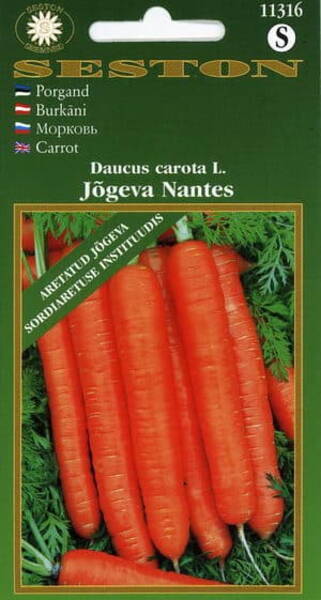Medium early, growing time 100-120 days.
Root: semi-long (12-16 cm), cylindrical, blunt tip, red-orange.
Flesh: thick, delicious, tender, juicy. Small core, slightly paler than the skin. Satisfactory storing properties, suitable for late autumn use.
1 gram = 850 seeds.
* Carrots removed from the garden, although they stop growing, remain living organisms. Vital processes slow down but do not stop.
Plastic substances in the roots gradually rearrange so that in spring, after planting, a flower-bearing shoot can develop from the root.
With optimal storage of the roots, the period of physiological dormancy can last 5–6 months or more, during which all valuable qualities for humans are preserved in the carrot.
Immature carrots should not be stored. Such roots can be found among all types of varieties: early, medium, and late.
They form as a result of unfavorable growing conditions during the vegetation period: delayed germination, lack of moisture at the beginning of growth, or overcrowding of sowing.
An immature root may have a normal size, but its tip is very pointed, turning into a long colorless rootlet. Even in varieties with a conical shape, the mature carrot’s tip ends slightly blunt with a very thin, easily detachable rootlet. However, do not break off the rootlets, as this is an injury to the carrot; during storage, they dry and fall off on their own.
Immature carrots store poorly and soon start growing again. Therefore, it is better to use them for food or processing rather than storing.
Finally, the third condition is proper trimming of the tops for carrots, beets, turnips, radishes, and other root crops. The tops should not be pulled off but cut with a sharp knife 1.0–1.5 cm from the root crown. If leaf stalks remain large or crushed, they will rot quickly, damaging the roots. If leaves are cut too close to the base, the exposed root crowns will also rot faster.
During storage, the remaining leaf stalk stubs gradually dry and fall off, as the roots physiologically mature and the growth point at the top enters dormancy. However, roots must always be inspected, and diseased roots, detached stalks, and rootlets removed. At a constant low temperature not exceeding +3–+4°C, roots remain in dormancy until the end of April–early May.
Did you know that... cooked carrots are healthier than raw. Compared to raw, cooked carrots contain three times more antioxidants that protect the body from cancer. These findings were obtained by a team of scientists at the University of Arkansas. Research showed that immediately after cooking, the level of antioxidants in carrots increases by 34% and continues to rise during the first week of storage. As noted by the group leader Luke Howard, new chemical compounds from the phenol group with high antioxidant activity form in cooked carrots and carrot puree.
Antioxidants are chemicals that prevent DNA cell damage from free radicals, which are by-products of metabolism. It has been established that they help prevent the development of diseases such as cancer and Alzheimer’s disease.












